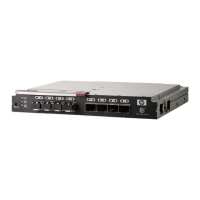Security
Table 22 highlights some of the key security features available for the DC04 SAN Director running
Fabric OS 6.2.0a or later, and for other HP enterprise-class platforms running Fabric OS 5.2.0 or
later. For details, contact HP.
Table 22 Security features
DescriptionSecurity Features
Login bannerDH-CHAP
Monitoring of attempted security breaches (via audit log-
ging)
SSHv2 (using AES, 3DES, RSA)
Monitoring of attempted security breaches (via Fabric Watch
Security Class)
HTTPS (using AES)
FC security policies: DCC and SCCSNPMv3
Trusted Switch (FCS) for central security managementFC-SP
Management access controls (SNMPv3, Telnet, FTP, serial
port, front panel)
Secure RPC
Hardware-enforced zoning by WWN and/or domain/port
ID
Secure file copy (SCP)
Default zoningTelnet disable
RSCN suppression and aggregationTelnet timeout
Configurable RSCN suppression by portIP filters (block listeners)
NTPv3 (to synchronize timestamps)Secure passwords (centralized control via RADI-
US/CHAP)
Event auditingMultiple User Accounts (MUAs). Up to 255.
Change trackingRole-Based Access Controls (RBACs)
Firmware change alerts in Fabric ManagerAdministrative domains/Virtual fabrics
Persistent port disableBoot PROM password reset
Persistent domain IDPassword hardening policies
E_port disableUpfront login in Web Tools
Network manageability
The DC04 SAN Director has a single domain and is managed as a single element with the Data
Center Fabric Manager (DCFM) Graphical User Interface (GUI) application. The DC04 SAN Director
responds to its own IP address and appears as a separate entity to the Telnet protocol and SNMP.
All management interfaces, such as Telnet, Web Tools, standards compliant SMI-S, and Management
Server, support a “port N within blade M” naming scheme.
HP StorageWorks DC and DC04 SAN Backbone Director Switches 121

